The ancient roots of bowling remain shrouded in mystery, leaving historians to speculate on its inception. There are indications that the ancient Egyptians might have engaged in a primitive form of the game some 5,000 years ago, yet concrete evidence is sparse.
Flinders Petrie, a prominent archaeologist renowned for his expertise in Egyptology, left an indelible mark on the field. His meticulous work included measurements of Stonehenge and surveys of Egyptian structures like the Great Pyramids. Petrie’s precision extended to the collection of pottery fragments, earning him the moniker “Abu Bagousheh” or “father of pots” among locals.
Petrie’s dedication led him to delve extensively into excavation work across Palestine and Egypt, unearthing nearly 3,000 tombs in Naqada. His detailed recordings uncovered intriguing artifacts, such as stone balls resembling bowling pins and small balls akin to marbles. While suggestive, interpreting these findings as evidence of ancient bowling remains contentious.
Petrie’s interpretation of these discoveries, notably the assortment of stone balls and vase-shaped objects found in tombs, stirred discussions among archaeologists. However, the connection between these artifacts and bowling remains speculative, with experts cautioning against drawing definitive conclusions based solely on their proximity in the same cemetery.
Though ancient Egypt may hint at bowling’s origins, historical documentation suggests diverse origins. From Roman soldiers engaging in ball-rolling games to references in German history around 300 AD, bowling-like activities were prevalent. Bowling’s recreational allure even led to bans and regulations, such as King Edward III’s prohibition in 1366 due to its impact on archery practice and subsequent legislative restrictions in various regions.
As bowling’s popularity surged, organizations like the American Bowling Congress emerged in the late 19th century to formalize the sport, setting the stage for national tournaments and standardized regulations.
Bowling Facts You Didnt Know
- Before its recreational use, bowling-like games were part of religious ceremonies in ancient cultures. Some societies used stone balls to symbolize fertility or celestial bodies in rituals.
- In medieval Germany, some towns imposed bans on bowling due to its association with gambling and rowdiness. Authorities sought to curb the game’s disruptive influence on society.
- Bowling faced legal challenges in various countries during the 19th century. In response to gambling concerns, several states in the United States prohibited nine-pin bowling, leading to the creation of the ten-pin variant to circumvent the bans.
- Bowling has been intertwined with social movements. During the women’s suffrage movement in the early 20th century, bowling alleys became places where women could gather and discuss social issues.
- The oldest known bowling alley, discovered in Egypt, dates back over 7,000 years. Its purpose wasn’t solely recreational; it was a site where ancient Egyptians engaged in ball-rolling games.
- The first indoor bowling alley in the United States was established in New York City in 1840. It quickly gained popularity among the elite class.
- In some historical periods, bowling served as a subtle form of political dissent. Satirical bowling-themed caricatures or political cartoons were used to convey messages or criticize political figures.
- Bowling found its way into literary works. Herman Melville, in his novel “Moby-Dick,” included a scene where the characters engage in a game resembling bowling on a ship deck.
- During World War II, bowling alleys in the United States were used to boost morale among soldiers. Many military bases had bowling facilities as part of recreational activities for servicemen.
- Astronauts aboard the Skylab space station in the 1970s experimented with bowling in microgravity conditions. While unconventional, it highlighted the versatility and adaptability of the sport.
Cultural Significance of Ancient Egyptian Bowling
The relationship between ancient Egyptian bowling and religious or cultural rituals remains a subject of debate among historians and archaeologists. While some argue that the presence of bowling-like games in tombs signifies a recreational pastime, others delve deeper into the symbolic significance of these activities. Exploring whether these games held religious connotations or represented a form of tribute to the afterlife adds depth to understanding ancient Egyptian beliefs and practices.
Evolution of Bowling Implements in Ancient Egypt
Examining the purpose behind the stone balls and vase-shaped objects discovered in Egyptian tombs prompts discussions regarding their functional use or symbolic significance. While some interpretations suggest these objects served as gaming tools, others propose they might have held deeper symbolic meanings, potentially representing cosmic elements or ceremonial offerings. Exploring these diverging viewpoints sheds light on the diverse roles these artifacts might have played in ancient Egyptian society.
Socioeconomic Impact of Ancient Egyptian Bowling
Debates arise regarding the societal implications of bowling in ancient Egypt, particularly in understanding its accessibility across different social strata. Investigating whether bowling was a pastime exclusive to the elite or if it permeated various societal levels offers insights into ancient Egyptian social structures, leisure activities, and potential avenues for social interaction among different classes.
Advanced Craftsmanship or Utilitarian Simplicity?
The craftsmanship evident in the creation of stone balls and other bowling-related artifacts raises questions about the technological sophistication of ancient Egyptian society. Some scholars argue that the precision and artistry displayed in these objects signify advanced craftsmanship, while others posit that their simplicity suggests utilitarian rather than technologically advanced origins. Exploring these perspectives enriches our understanding of ancient Egyptian craftsmanship and technological capabilities.
Trade and Cultural Exchange Through Ancient Egyptian Bowling
Investigating the potential connections between ancient Egyptian bowling practices and other cultures offers insights into early trade routes and cultural exchanges. Debates center on whether bowling-like games found in Egyptian contexts might have influenced or been influenced by neighboring civilizations, indicating broader cultural interactions in the ancient world and potential avenues for shared gaming traditions.
Bowling Strategies To Win…Now That You Know The History
- When considering your bowling strategy, it’s crucial to factor in the weight of your ball and the conditions of the lane. Experiment with different ball weights to find what’s comfortable and controllable for you. Additionally, observe the lane conditions—whether they are oily or dry—so you can adjust your approach and ball choice accordingly. A heavier ball might offer more power but could be harder to control, especially on dry lanes, while a lighter ball might provide better precision on oily surfaces.
- Developing a consistent bowling stance and approach significantly impacts your game. Work on establishing a comfortable and balanced stance that suits your style. Focus on a smooth, controlled approach, maintaining a consistent speed and angle of delivery. A well-practiced approach can enhance your accuracy and increase the chances of hitting your target consistently.
- Your release technique plays a pivotal role in the outcome of your throw. Practice various release techniques—whether it’s the conventional, fingertip, or semi-fingertip grip—to find what feels most natural and effective for you. Concentrate on a smooth and controlled release, aiming for a consistent motion to impart the desired spin and direction to your ball for increased accuracy.
- Spare shooting is a critical aspect often overlooked in bowling strategy. Develop a systematic approach to spare conversions by aiming at specific areas of the lane and adjusting your technique accordingly. Practice targeting corner pins and challenging spare setups to improve your spare conversion rate, ultimately boosting your overall score.
- A strong mental game is as vital as your physical technique. Focus on maintaining a positive mindset, staying focused on each shot, and adapting to changing lane conditions. Confidence in your abilities and a flexible approach to adjust to the evolving game dynamics will significantly impact your overall performance.




